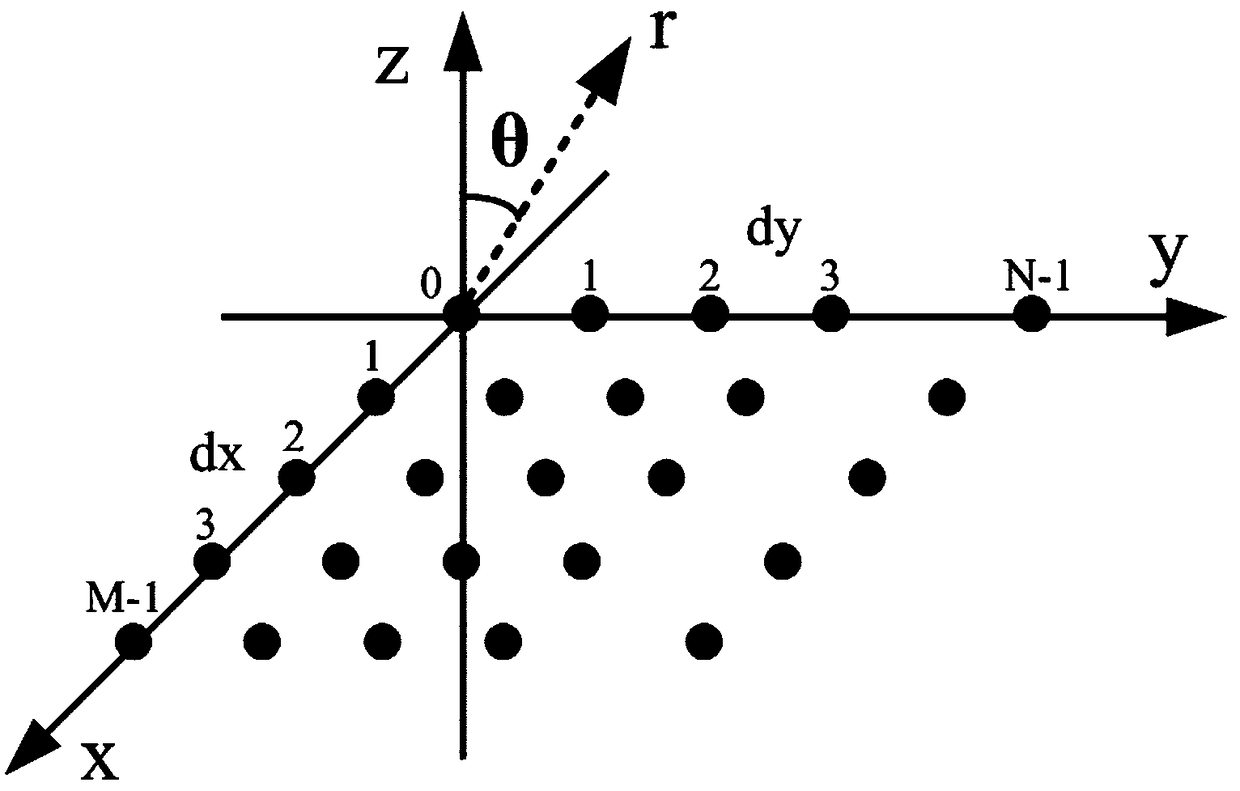Method for generating two-dimensional identical-focal spot array by using radiation field of planar array antenna
A planar antenna and radiation field technology, applied in the direction of optical components, optics, instruments, etc., can solve the problems of not achieving the best effect, uneven intensity distribution of focal spots, difficult control of the number and position of focal spots, etc. control effect
- Summary
- Abstract
- Description
- Claims
- Application Information
AI Technical Summary
Problems solved by technology
Method used
Image
Examples
Embodiment 1
[0067] Coefficient C 0 And C 1 Since it has nothing to do with the focal spot shape in the array, it is normalized to 1 for simplicity. The field radiated from the antenna array should be completely collected and collimated to the pupil surface for the construction of the focal spot array. Therefore, the maximum radiation angle of the lens is set to θ max =π / 2, the corresponding numerical aperture NA=1, this value can be achieved by using a reflective lens or a hyperplane lens. Here are four different types of specific focal spot arrays to demonstrate the simplicity and flexibility of the proposed method. It consists of 2×3, 3×2, 3×3 array elements, separated by d x =2.5λ and d y =5.0λ, d x =5.0λ and d y =2.5λ, d x =2.5λ and d y =2.5λ, the radiation field of the arranged rectangular dipole array (including the square array) is used to generate a two-dimensional array of the same focal spot, such as figure 2 Shown. From figure 2 It can be clearly seen that the focal spots on ...
Embodiment 2
[0069] If five dipole antennas are arranged diagonally, the interval is d x =1.5λ and d y =1.5λ, with its radiation pattern, a diagonal focal spot array can be easily generated on the XY focal plane, such as image 3 Shown. Similarly, the intensity of each focal spot is the same, and its center position can be adjusted by adjusting the parameter d x And d y To customize. image 3 Among them, (a) is the right diagonal focal spot array, (b) is the left diagonal focal spot array, and (c) is the V-shaped focal spot array.
Embodiment 3
[0071] Figure 4 Shown are regular pentagon, regular hexagon, and regular octagonal focal spot arrays. These regular polygon focal spot distributions are easily realized by using the radiation field of an antenna array with regular pentagon, regular hexagon and regular octagonal arrangement. Obviously, this method can also be used to generate other polygonal focal spot arrays. This shows that the required polygonal focal spot array can be obtained by inverting the radiation field of the corresponding polygonal dipole array, and the center position of each focal spot on the XY focal plane can be adjusted by adjusting the coordinates of the corresponding dipole array element To manipulate. Figure 4 Among them, (a) is a regular pentagonal focal spot array, (b) is a regular hexagonal focal spot array, and (c) is a regular octagonal focal spot array.
PUM
 Login to View More
Login to View More Abstract
Description
Claims
Application Information
 Login to View More
Login to View More - R&D
- Intellectual Property
- Life Sciences
- Materials
- Tech Scout
- Unparalleled Data Quality
- Higher Quality Content
- 60% Fewer Hallucinations
Browse by: Latest US Patents, China's latest patents, Technical Efficacy Thesaurus, Application Domain, Technology Topic, Popular Technical Reports.
© 2025 PatSnap. All rights reserved.Legal|Privacy policy|Modern Slavery Act Transparency Statement|Sitemap|About US| Contact US: help@patsnap.com



